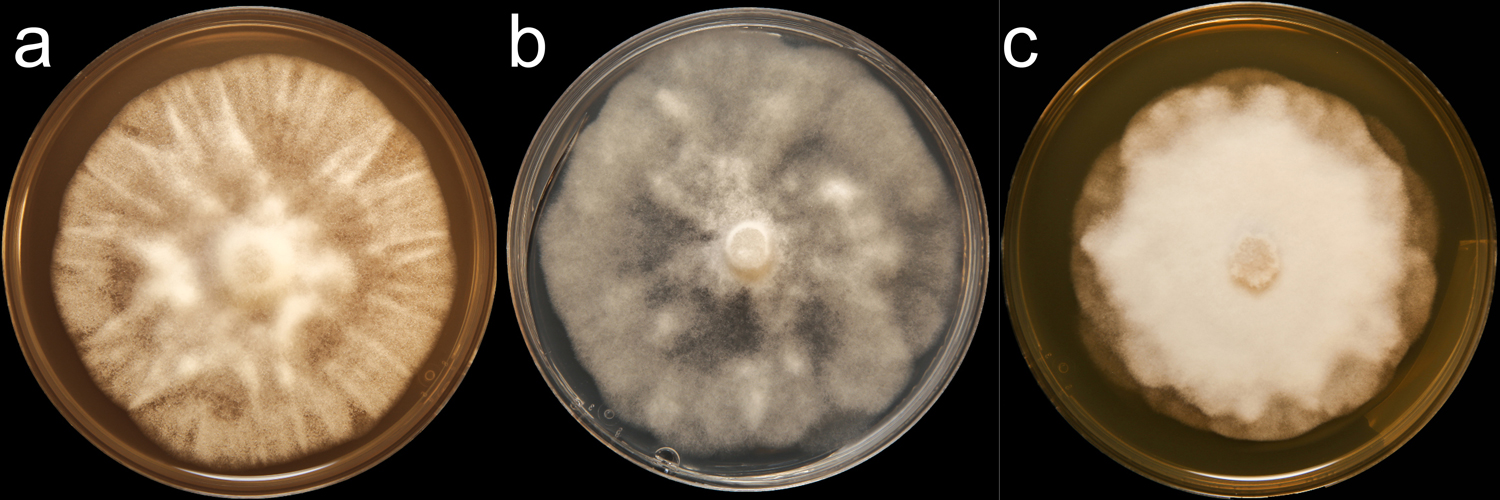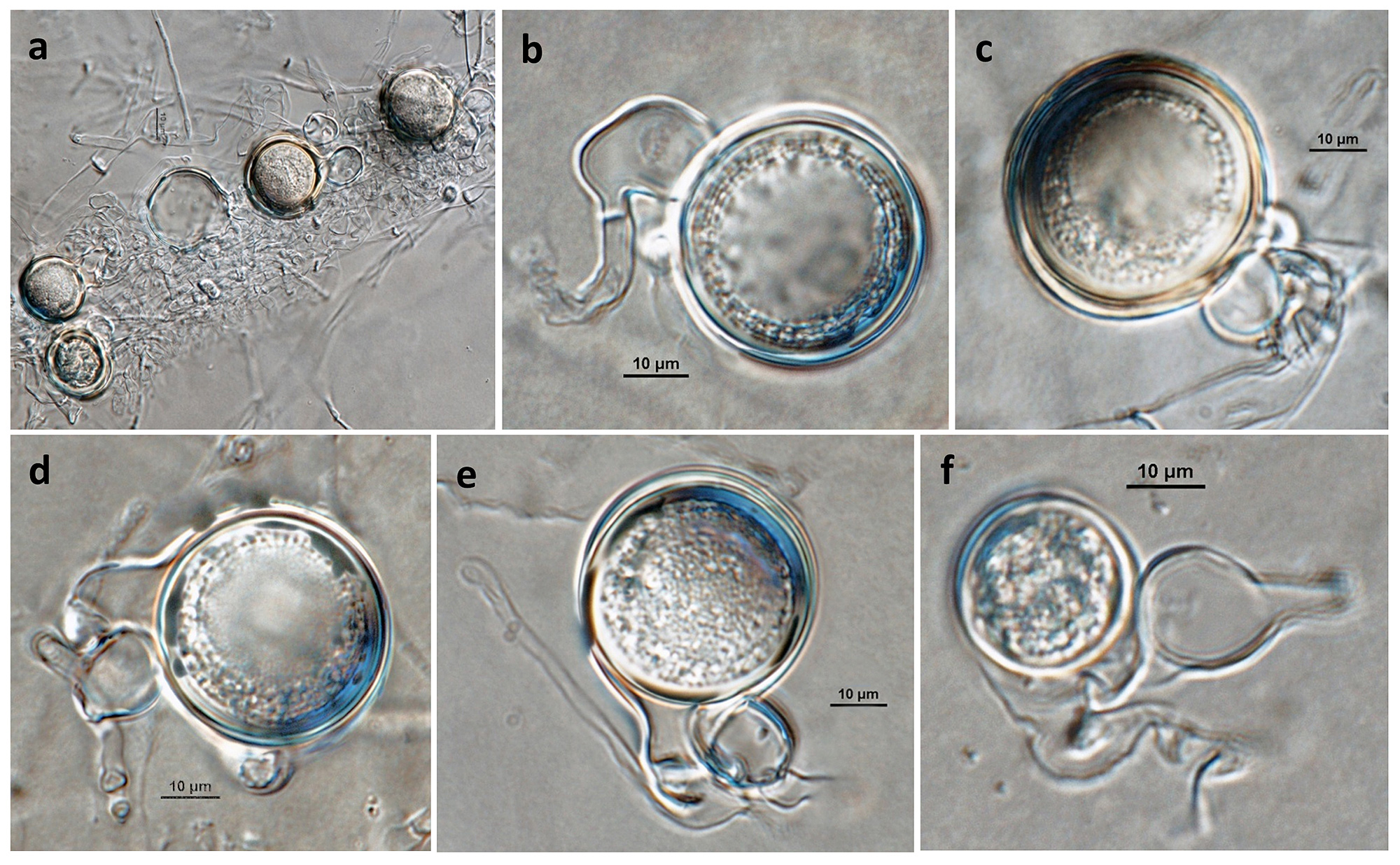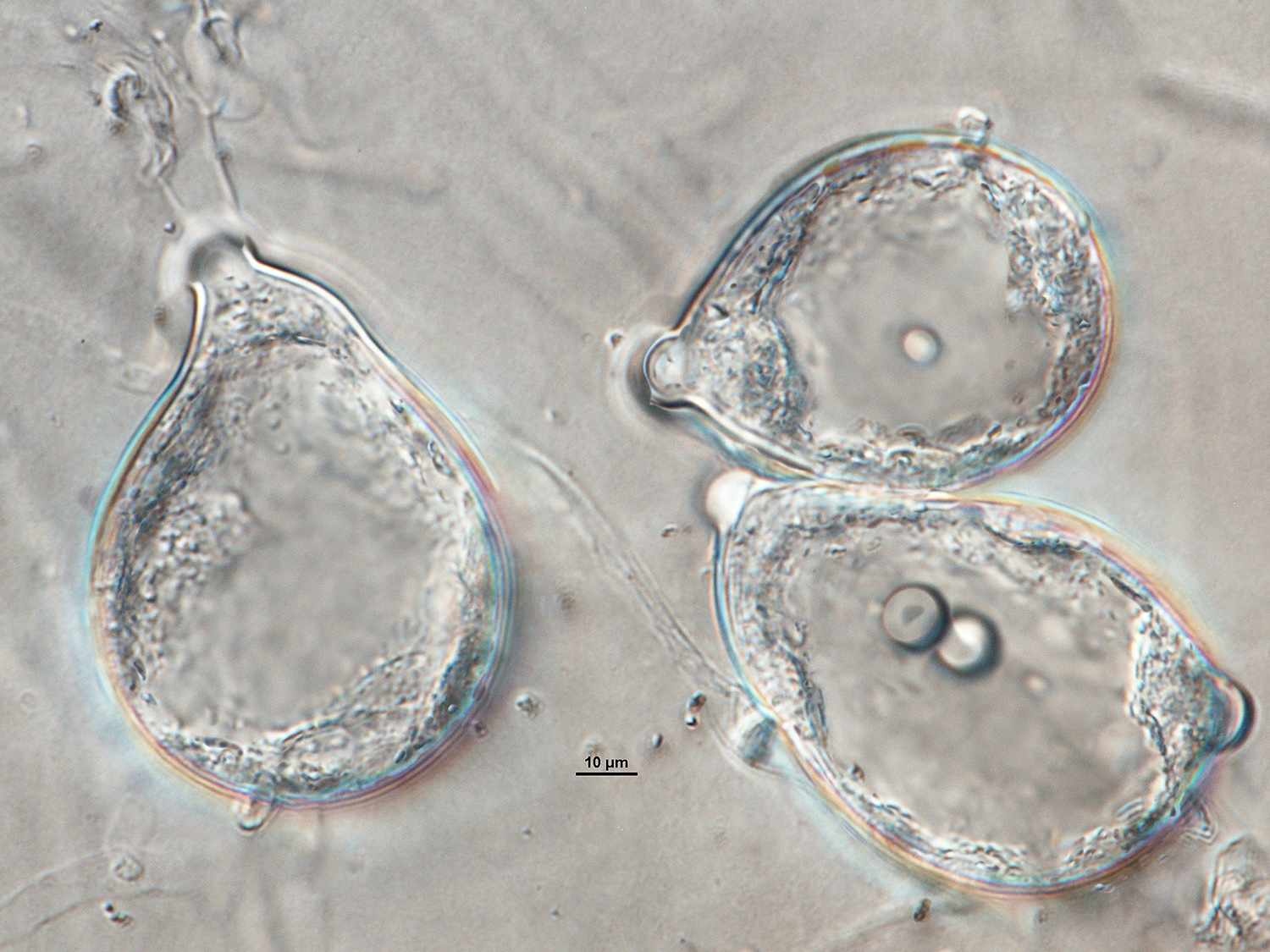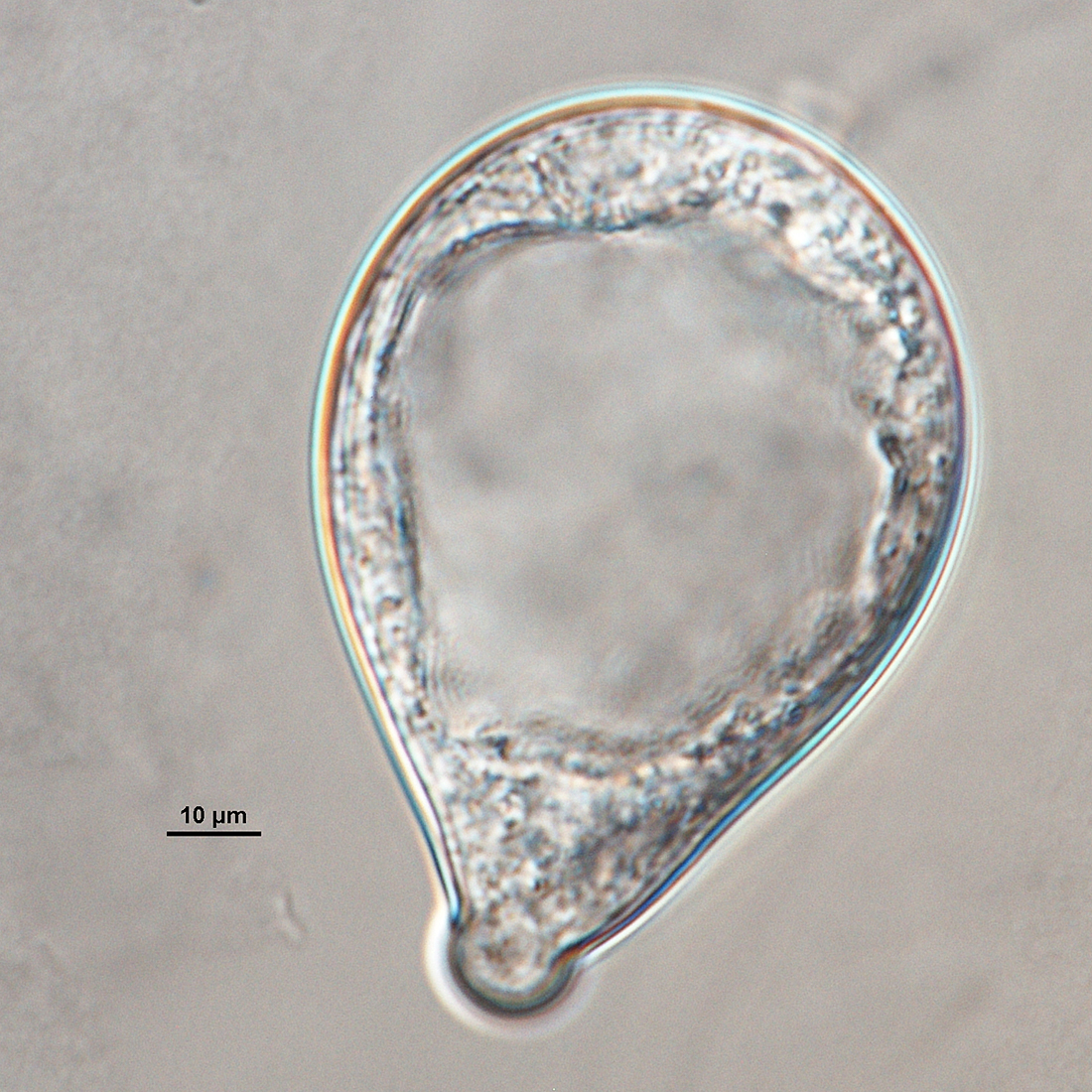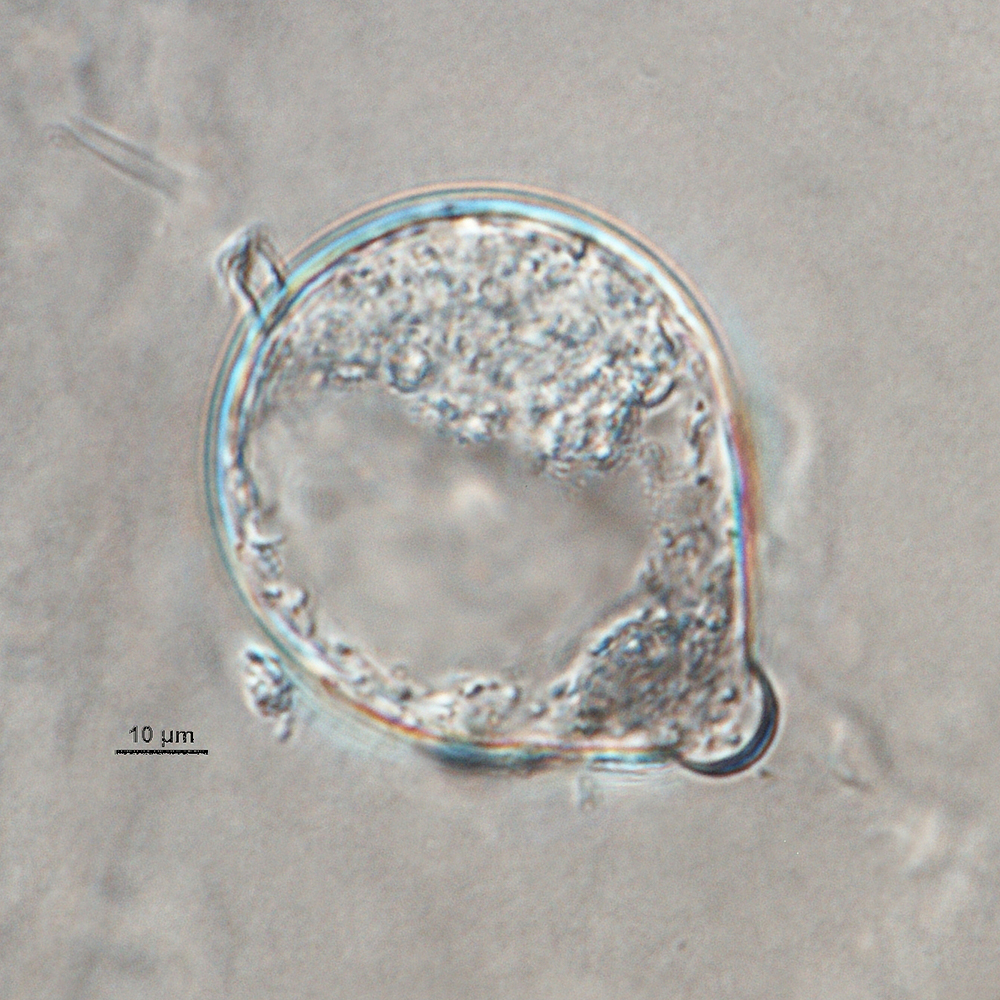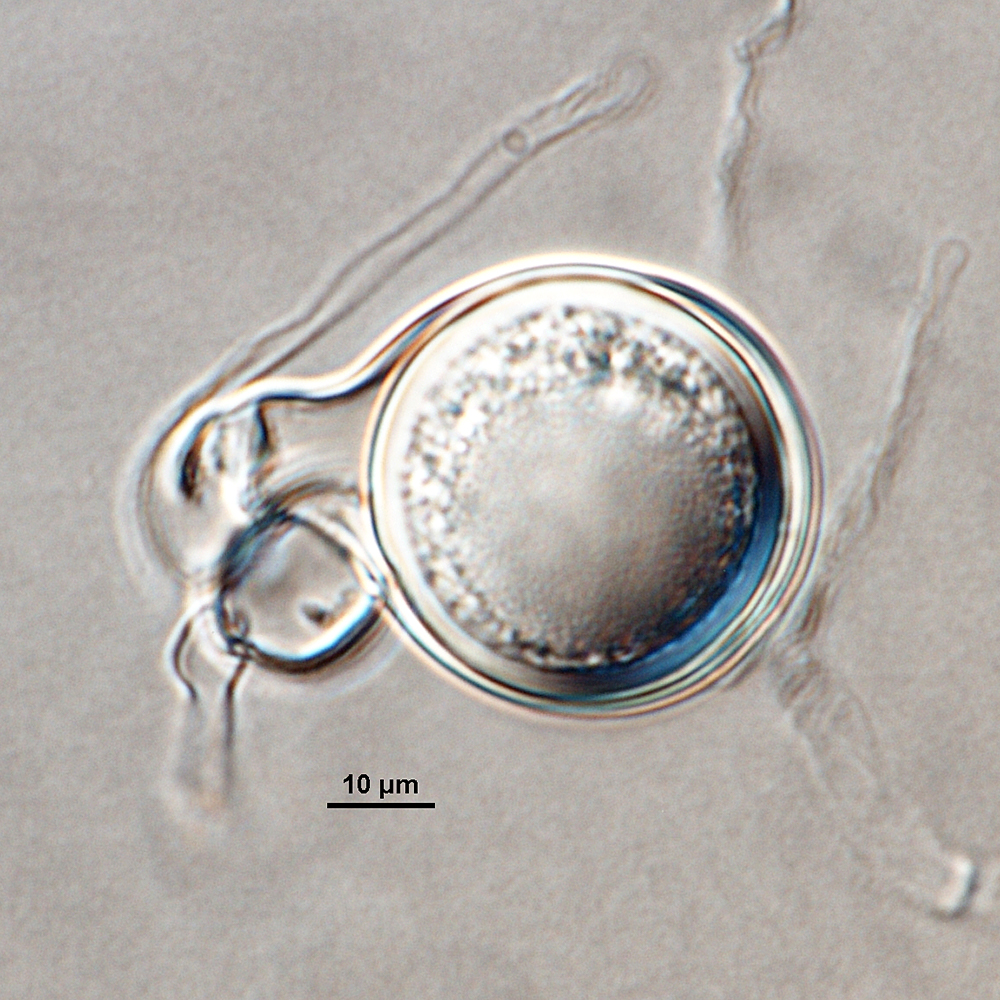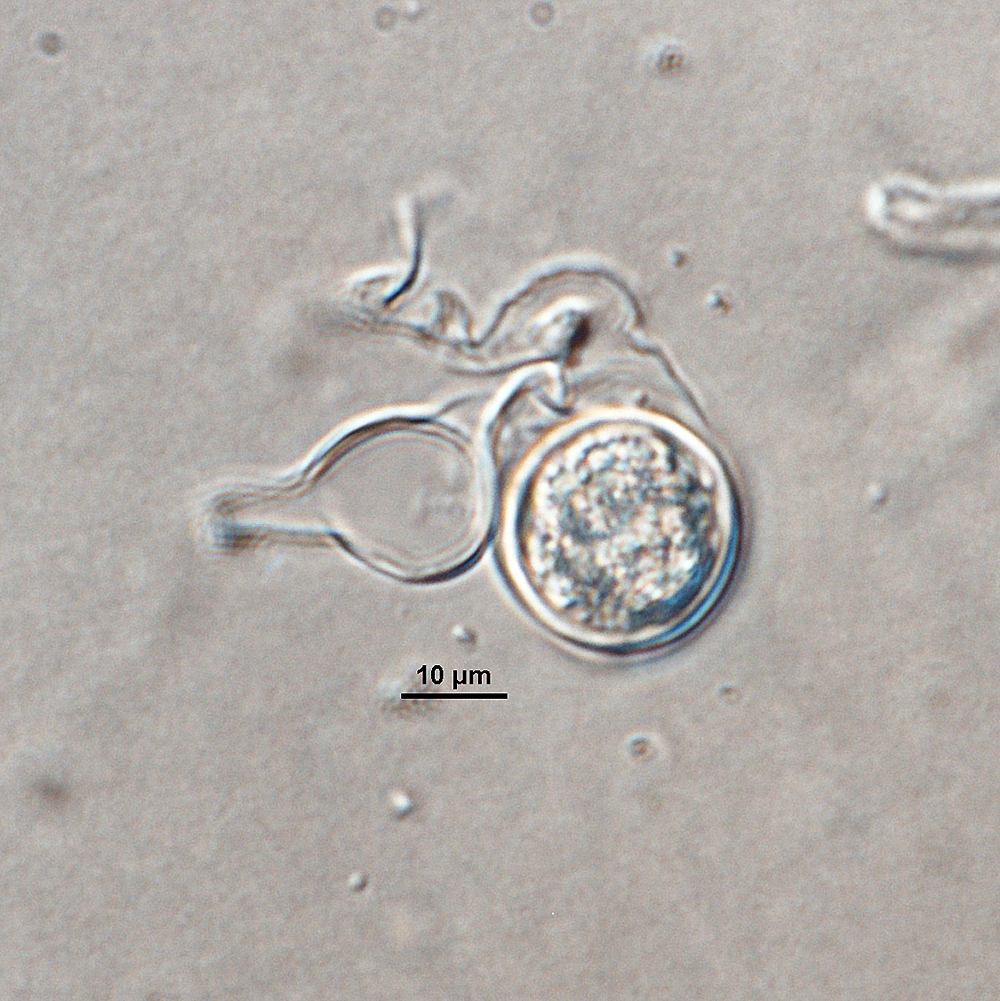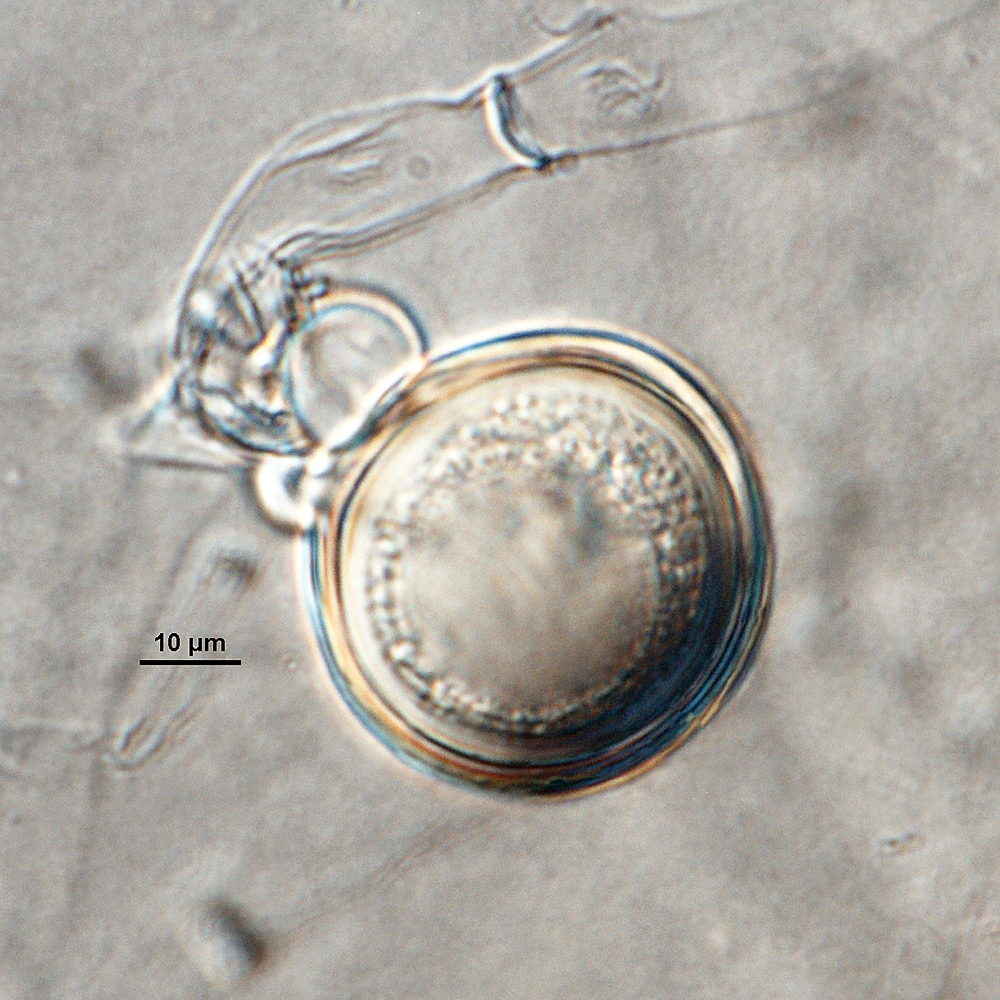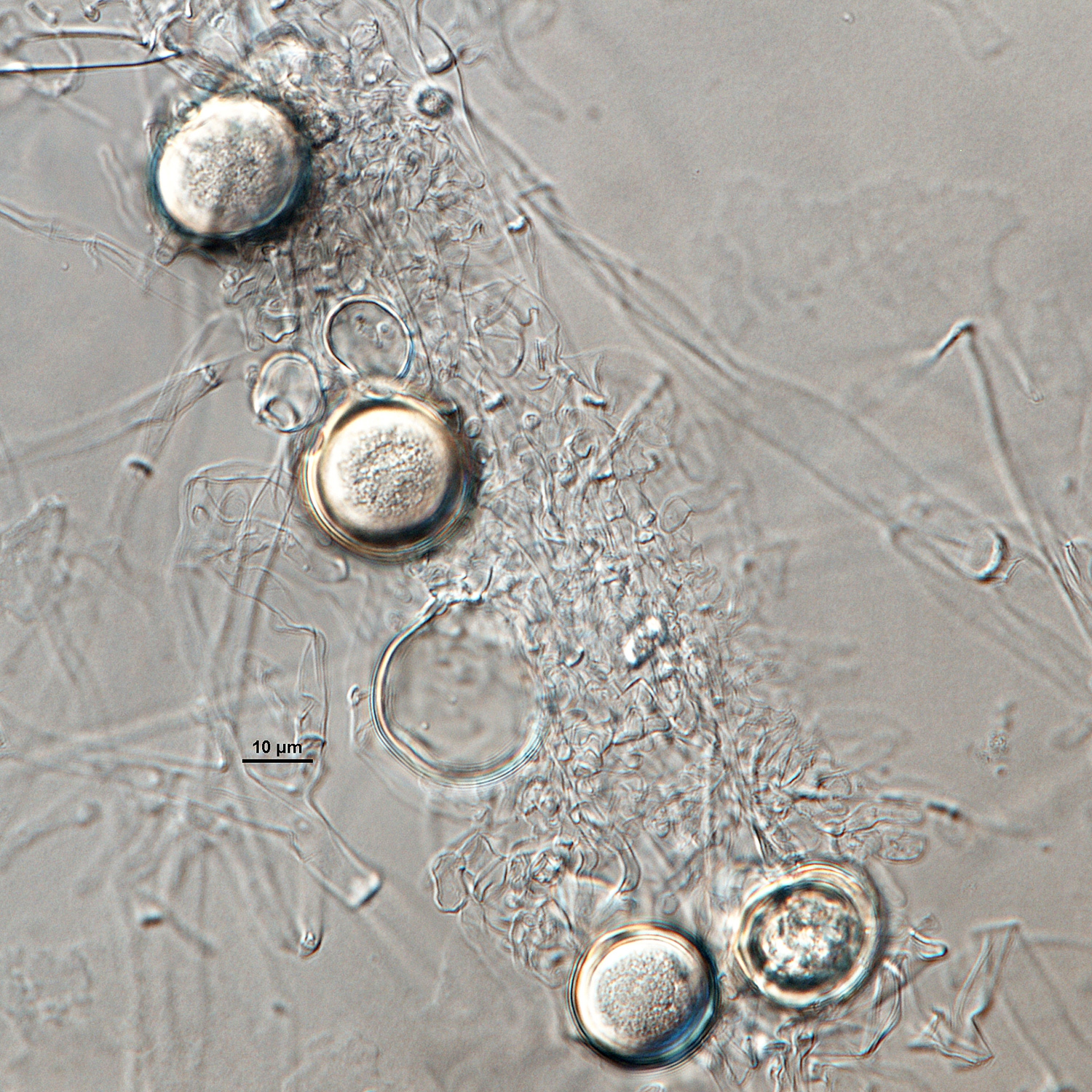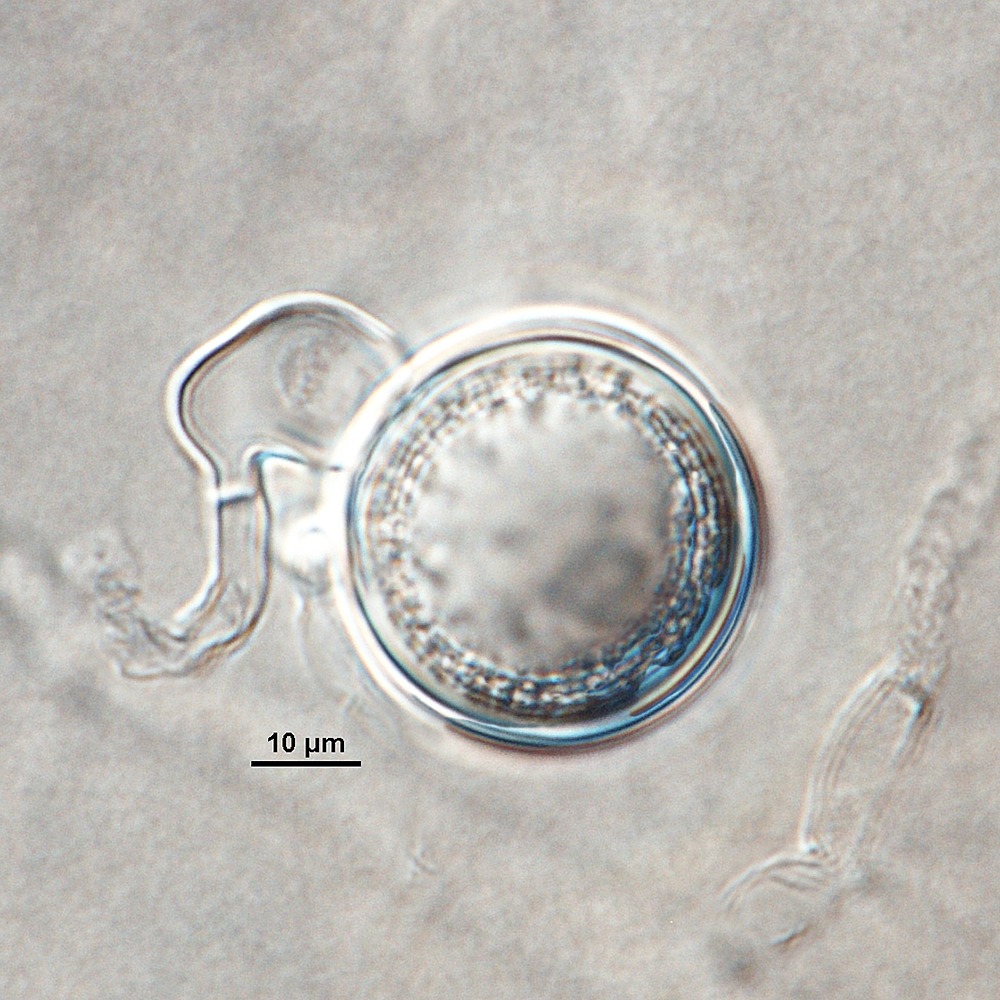Phytophthora mengei
|
Phytophthora spp. in subclade 2b: portion of the seven-loci ML phylogeny featuring the type cultures of 212 described species (by T. Bourret). Notice the position of P. mengei Ex-type ATCC MYA-4554 = S&T BL 31. Gloria Abad, USDA S&T.
|
|
Phytophthora spp. in subclade 2b: Morphological Tabular key (PDF) and Tabular key legends (PDF) in IDphy2 KEY SECTION. Notice the data of P. mengei Ex-type ATCC MYA-4554 = S&T BL 31. Gloria Abad, USDA S&T.
|
|
Phytophthora mengei (CPHST BL 31) colonies of the ex-type grown for 7 days on (a) V8® Agar, (b) potato dextrose agar, and (c) malt extract agar; photo by Krysta Jennings and Leandra Knight, USDA-APHIS-PPQ |
|
Phytophthora mengei (ex-type CPHST BL 31) sexual phase: (a–f) oogonia with antheridia paragynous, and plerotic oospores; (d–f) oogonia with tapered stalks and with a slight hook in the taper; photos by Gloria Abad, USDA-APHIS-PPQ. |
|
Phytophthora mengei (ex-type CPHST BL 31) asexual phase: (a) sporangia semipapillate, persistent, ellipsoid, ovoid, and irregular shapes, produced in simple sympodial or in single long sporangiophores; hyphal swellings rarely produced (arrows); (b) sporangia semipapillate with one and two papillae; (c) sporangium semipapillate persistent; folding of sporangiophore giving the appearance to be a short pedicel; photos by Gloria Abad, USDA-APHIS-PPQ. |
|
Phytophthora mengei (ex-type CPHST BL 31) asexual phase: sporangia semipapillate with one and two papillae; photo by Gloria Abad, USDA-APHIS-PPQ. |
|
Phytophthora mengei (ex-type CPHST BL 31) asexual phase: semipapillate sporangium; photo by Gloria Abad, USDA-APHIS-PPQ. |
|
Phytophthora mengei (ex-type CPHST BL 31) asexual phase: semipapillate sporangium; photo by Gloria Abad, USDA-APHIS-PPQ. |
|
Phytophthora mengei (ex-type CPHST BL 31) sexual phase: plerotic oospore with paragynous antheridium, and oogonium with tapered stalk and with a slight hook in the taper; photo by Gloria Abad, USDA-APHIS-PPQ. |
|
Phytophthora mengei (ex-type CPHST BL 31) sexual phase: plerotic oospore with paragynous antheridium, and oogonium with tapered stalk and with a slight hook in the taper; photo by Gloria Abad, USDA-APHIS-PPQ. |
|
Phytophthora mengei (ex-type CPHST BL 31) sexual phase: plerotic oospore with paragynous antheridium, and oogonium with tapered stalk and with a slight hook in the taper; photo by Gloria Abad, USDA-APHIS-PPQ. |
|
Phytophthora mengei (ex-type CPHST BL 31) sexual phase: plerotic oospore with paragynous antheridium; photo by Gloria Abad, USDA-APHIS-PPQ. |
|
Phytophthora mengei (ex-type CPHST BL 31) sexual phase: plerotic oospore with paragynous antheridium; photo by Gloria Abad, USDA-APHIS-PPQ. |
|
Phytophthora mengei (ex-type CPHST BL 31) sexual phase: plerotic oospore with paragynous antheridium; photo by Gloria Abad, USDA-APHIS-PPQ. |
|
Phytophthora mengei (ex-type CPHST BL 31) asexual phase: sporangia semipapillate, persistent, ellipsoid, ovoid, and irregular shapes, produced in simple sympodial or in single long sporangiophores; hyphal swellings rarely produced; photo by Gloria Abad, USDA-APHIS-PPQ. |
Name and publication
Phytophthora mengei G.T. Browne, Gallegly & C.X. Hong (2009)
Hong CX, Gallegly ME, Browne GT, Bhat RG, Richardson PA, and Kong P. 2009. The avocado subgroup of Phytophthora citricola constitutes a distinct species, Phytophthora mengei sp. nov. Mycologia 101: 833–840.
Corresponding author: C. Hong chhong2@vt.edu
Nomenclature
from Hong et al. (2009)
Mycobank
Etymology
refers to the originator (Dr John Menge) of the type culture and eight additional avocado isolates used in this study
Typification
Type: UNITED STATES, California, isolated from Persea americana by J. Menge (date unknown), ATCC MYA-4554 a cryopreserved specimen of M218.z1
Ex-type: ATCC MYA-4554 (= mengei ET.CH-2008b.42B2 STRAIN 42B2)
Sequences for ex-type in original manuscript: CH-2008b isolate 42B2 = ITSrDNA: EU748545
Ex-type in other collections
(ET) ATCC MYA-4554, WPC P16862, S&T BL 31 (Abad),42B2 (Hong), TJ1109 (Jung), p340 (Gallegly)
Molecular identification
Voucher sequences for barcoding genes (ITS rDNA and COI) of the ex-type (see Molecular protocols page)
Phytophthora mengei isolate CPHST BL 31 (= P16862 WPC) = ITS rDNA MG865539, COI MH136932
Voucher sequences for Molecular Toolbox with seven genes (ITS, β-tub, COI, EF1α, HSP90, L10, and YPT1
(see Molecular protocols page) (In Progress)
Voucher sequences for Metabarcoding High-throughput Sequencing (HTS) Technologies [Molecular Operational Taxonomic Unit (MOTU)]
(see Molecular protocols page) (In Progress)
Sequences with multiple genes for ex-type in other sources
- NCBI: Phytophthora mengei CPHST BL 31
- NCBI: Phytophthora mengei 42B2
- EPPO-Q-bank: Phytophthora mengei
- BOLDSYSTEMS: Phytophthora mengei (barcoding COI & ITS)
Position in multigenic phylogeny with 7 genes (ITS, β-tub, COI, EF1α, HSP90, L10, and YPT1)
Clade clade:
a taxonomic group of organisms classified together on the basis of homologous features traced to a common ancestor
2b
Morphological identification
Colonies and cardinal temperatures
Colony colony:
assemblage of hyphae which usually develops form a single source and grows in a coordinated way
morphology after 7 days of growth on V8 agar, potato dextrose agar, and malt extract with no distinct pattern to slightly radiate. Minimum temperature for growth is 6°C, optimum 25°C, and maximum 33°C.
Asexual phase
SporangiaSporangia:
sac within which zoospores form, especially when water is cooled to about 10°C below ambient temperature; in solid substrates, sporangia usually germinate by germ tubes
semipapillatesemipapillate:
pertaining to the production of shallow having papilla that are not well developed, shallow and less nipple-like than fully papillate structures
; persistentpersistent:
pertaining to sporangia that remain attached to the sporangiophore and do not separate or detach easily (cf. caducous)
; ellipsoidellipsoid:
refers to a solid body that forms an ellipse in the longitudinal plane and a circle in cross section; many fungal spores are ellipsoidal or elliptic
, ovoidovoid:
egg-shaped, with the widest part at the base of the sporangium and the narrow part at the apex
, and irregular shapes, ellipsoidellipsoid:
refers to a solid body that forms an ellipse in the longitudinal plane and a circle in cross section; many fungal spores are ellipsoidal or elliptic
sporangia sometimes with a constriction in the middle (37–95 L x 27–44 W µm.); empty sporangiasporangia:
sac within which zoospores form, especially when water is cooled to about 10°C below ambient temperature; in solid substrates, sporangia usually germinate by germ tubes
have a small plug at the point of pedicelpedicel:
the hyphal base of a sporangium that remains attached after the sporangium separates, or is shed, from the sporangiophore; the pedicel may be short (< 5 µm), medium (5–20 µm), or long (> 20 µm)
attachment. SporangiaSporangia:
sac within which zoospores form, especially when water is cooled to about 10°C below ambient temperature; in solid substrates, sporangia usually germinate by germ tubes
produced in simple sympodial or in single long sporangiophores. Hyphal swellings rarely produced. ChlamydosporesChlamydospores:
an asexual spore with a thickened inner wall that is delimited from the mycelium by a septum; may be terminal or intercalary, and survives for long periods in soil
absent.
Sexual phase
Homothallic. OogoniaOogonia:
the female gametangium in which the oospore forms after fertilization by the antheridium
spherical (20–27 µm diam.) some with tapered stalks or with a slight hook in the taper; antheridia paragynousparagynous:
pertaining to the sexual stage in which the antheridium is attached to the side of the oogonium (cf. amphigynous)
and commonly asymmetrically capitate; oosporesoospores:
zygote or thick-walled spore that forms within the oogonium after fertilization by the antheridium; may be long-lived
predominantly pleroticplerotic:
pertaining to an oospore that fills the oogonium (cf. aplerotic)
(19–25 µm diam.) or slightly apleroticaplerotic:
pertaining to a mature oospore that does not fill the oogonium; i.e. there is room left between the oospore wall and oogonium wall (cf. plerotic)
.
Most typical characters
Phytophthora mengei is characterized by the presence of oogoniaoogonia:
the female gametangium in which the oospore forms after fertilization by the antheridium
with tapered stalks with a slight hook in the taper.
Specimen(s) evaluated
Phytophthora mengei ex-type CPHST BL 31 = P16862 (World Phytophthora Collection)
Hosts and distribution
Distribution: North America (USA: CA)
Substrate: trunks, roots, fruits
Disease note: canker
Host: Persea americana (Lauraceae)
Retrieved January 31, 2018 from U.S. National Fungus Collections Nomenclature Database.
Additional references and links
- SMML USDA-ARS: Phytophthora mengei
- EPPO Global Database: Phytophthora mengei
- Forest Phytophthora of the world: Phytophthora mengei
- CABI Digital Library: Phytophthora mengei
- Encyclopedia of Life (EOL): Phytophthora mengei
- Index Fungorum (IF): Phytophthora mengei
- Google All Phytophthora mengei
- Google Images Phytophthora mengei
- Google Scholar Phytophthora mengei
Fact sheet author
Z. Gloria Abad, Ph.D., USDA-APHIS-PPQ-S&T Plant Pathogen Confirmatory Diagnostics Laboratory (PPCDL), United States of America.

